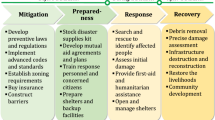Abstract
Nowadays, visual analytics dashboard for decision support system for disaster management is very essential, as the frequency of several disasters is growing rapidly. It is very useful to take decision in time-sensitive environment from diverse rapid data set. Thus, it is critical to reduce the overhead in data integration and visualization for efficient decision making. Geographical map visualization can be an effective solution in such environments by providing an integrated approach to extract, integrate, and view diverse information. In this paper, an analytics dashboard has been developed for identifying and visualizing risk zones and vulnerable areas before disaster has occurred. For this, rescuer will have more time to be prepared and a better plan will be produced to rescue the people and reallocate them into safe areas.
Graphical Abstract








Similar content being viewed by others
References
Adhikari P, Hong Y, Douglas KR, Kirschbaum DB, Gourley J, Adler R, Brakenridge GR (2010) A digitized global flood inventory (1998–2008): compilation and preliminary results. Natural Hazards 55(2):405–422
Aurenhammer F, Klein R (2000) Voronoi diagrams. Handb comput geom 5:201–290
Cançado V, Brasil L, Nascimento N, Guerra A (2008) Flood risk assessment in an urban area: measuring hazard and vulnerability. In: 11th International conference on urban drainage, Edinburgh, Scotland, UK
Cerutti V, Fuchs G, Andrienko G, Andrienko N, Ostermann F (2016) Identification of disaster-affected areas using exploratory visual analysis of georeferenced Tweets: application to a flood event. Association of geographic information laboratories in Europe pp 1–5
De Berg M, Van Kreveld M, Overmars M, Schwarzkopf OC (2008) Computational geometry, 3rd edn. Springer, Berlin Heidelberg
Dobrin A (2005) A review of properties and variations of Voronoi diagrams. Whitman College
EM-DAT: http://www.emdat.be/database. Accessed 26 Jan 2017
Fortune S (1987) A sweepline algorithm for Voronoi diagrams. Algorithmica 2(1–4):153–174
Gajdoš P, Radecký M (2009) Web visualization support for disaster management. In Internet Technology and Secured Transactions, 2009. ICITST 2009. International conference for IEEE, pp. 1–6
Gupta S, Knoblock C (2010) Building geospatial mashups to visualize information for crisis management. Proc, ISCRAM
Geographical information data set: www.gadm.org. Accessed 14 July 2016
Kemec S, Zlatanova S, Duzgun S (2009) Selecting 3D urban visualisation models for disaster management: a rule-based approach. In: Proceedings of TIEMS 2009 Annual Conference, pp. 9–11
Li C, Cheng X, Li N, Du X, Yu Q, Kan G (2016) A framework for flood risk analysis and benefit assessment of flood control measures in urban areas. Int J Env Res Pub Health 13(8):787
Li H, Zhang J, Sun J, Wang J (2017a) A visual analytics approach for flood risk analysis and decision-making in cultural heritage. J Vis Lang Comp 41:89–99
Li T, Xie N, Zeng C, Zhou W, Zheng L, Jiang Y, Chen SC (2017b) Data-driven techniques in disaster information management. ACM Comput. Surv (CSUR) 50(1):1
Liu Y (2009) Data-driven geospatial visual analytics for real-time urban flooding decision support. In: AGU fall meeting abstracts
Lu Y, Hu X, Wang F, Kumar S, Liu H, Maciejewski R (2015) Visualizing social media sentiment in disaster scenarios. In: Proceedings of the 24th International Conference on World Wide Web, ACM, pp. 1211–1215
Ma Y, Duan F, Liu H, Tian J, Duan G (2012) Research on the management and expression of disaster data. In: Proceedings of geoinformatics, 20th International Conference on IEEE, pp. 1–5
Malik A, Maciejewski R, Maule B, Ebert DS (2011) A visual analytics process for maritime resource allocation and risk assessment. IEEE Conference on visual analytics science and technology, pp. 221–230
Manna P (2016) Model for flood prediction/forecasting and flood risk assessment. M.Tech Thesis. Indian Statistical Institute, Kolkata, India
Parhi PK, Mishra SK, Singh R, Tripathi VK (2012) Floods in Mahanadi river basin Orissa (India): a critical review.India Water Week-Water Energy and Food Security
Rainfall Classification data set: www.imdkolkata.gov.in Accessed 02 Dec 2017
Review of Floods in West Bengal (with special reference to The Flood in September, 2000): Ref. PIL No. WP No. 113(W) of 2001—by The Committee of Experts constituted by the Hon’ble High Court, Calcutta
Smith K (1997) Environmental hazards: assessing risk and reducing disaster. Env Int 3(23):422
Smith K, Ward R (1998) Floods: physical processes and human impacts. John Wiley, New York
Supriya P, Krishnaveni M, Subbulakshmi M (2015) Regression analysis of annual maximum daily rainfall and stream flow for flood forecasting in Vellar River Basin. Aquatic Procedia 4th Edn, pp. 957–963
The Flood in September, 2000: Ref. PIL No. WP No. 113(W) of 2001—by The Committee of Experts constituted by the Hon’ble High Court, Calcutta
The Flood in September, 2000: Ref. PIL No. WP No. 113(W) of 2001—by The Committee of Experts constituted by the Hon’ble High Court, Calcutta
United Nations World Water Assessment Programme (UN-WWAP), 2006
WDR: World disaster report (2003) focus on ethics in aid. International federation of red cross and red crescent societies, Geneva, p. 240
WDR: World disaster report (2004) focus on community resilience. International federation of red cross and red crescent societies, Geneva, p. 240
Xie C, Ma G, Li Q, Xun J, Dong J (2016) Visual exploration of tsunami evacuation planning. J Vis 19(3):475–487
Acknowledgements
We would like to thank Prof. K. Koyamada and Prof. K. C. Kim, Editor-in-Chief of Journal of Visualization for being supportive towards the publication of this paper. Special thanks are due to the two anonymous reviewers whose comments greatly improved the presentation. Thanks are due to the Indian Statistical Institute Kolkata, India for funding this study. We are also thankful to the government personnel of Irrigation & Waterways Department of West Bengal and India Meteorological Department for their cooperation and help.
Author information
Authors and Affiliations
Corresponding author
Rights and permissions
About this article
Cite this article
Saha, S., Shekhar, S., Sadhukhan, S. et al. An analytics dashboard visualization for flood decision support system. J Vis 21, 295–307 (2018). https://doi.org/10.1007/s12650-017-0453-3
Received:
Revised:
Accepted:
Published:
Issue Date:
DOI: https://doi.org/10.1007/s12650-017-0453-3




